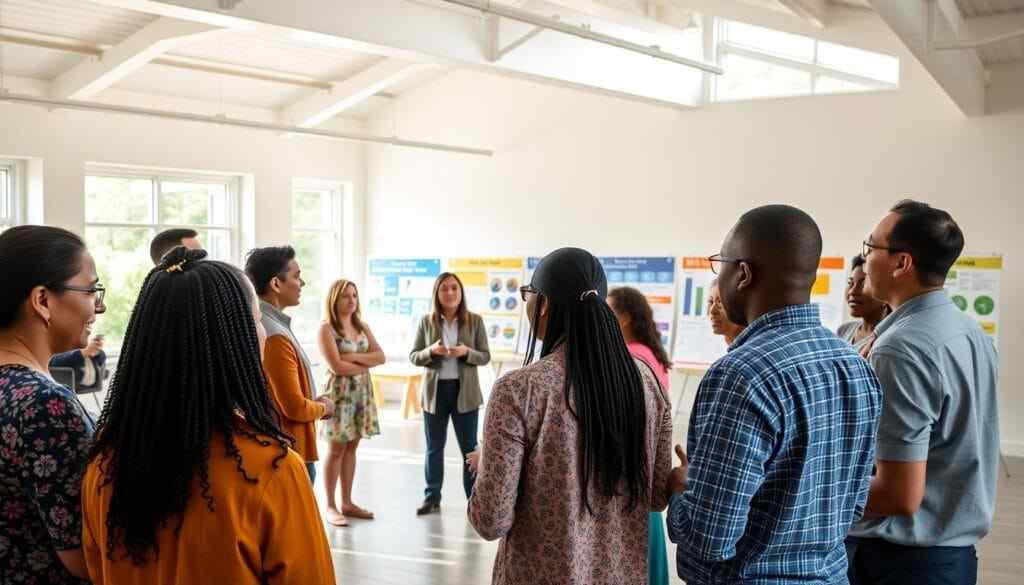What makes a community great for everyone to thrive? How do health and wellness programs help? These are key questions. Community health and wellness are essential for our lives. They help us understand the value of promoting health in a holistic way.
The Centers for Disease Control and Prevention (CDC) has made big efforts in this area. They have programs like Good Health and Wellness in Indian Country (GHWIC). This program aims to better health for American Indian and Alaska Native people.

Community health and wellness is more than just personal health. It’s about working together for everyone’s well-being. By starting community health initiatives, we can support healthy living. This helps everyone feel better and grow together.
Important Key Takeaways
- Community health and wellness is key for a supportive environment that promotes healthy living.
- Health promotion programs help build connections and support, leading to better well-being for all.
- Programs like GHWIC show the need for health approaches that fit each community’s culture.
- Community efforts can lower chronic diseases and their risks, like diabetes and tobacco use.
- Holistic well-being initiatives can greatly improve mental health, physical activity, and social ties.
- Community health programs can be designed for different groups, including American Indian and Alaska Native communities.
Understanding Community Health and Wellness Fundamentals
Community health and wellness are key parts of public health efforts. They aim to stop disease and encourage healthy living. Health education workshops are a big part of this, teaching people how to stay well.
Health education workshops play a big role in teaching healthy habits and preventing disease. They happen in places like community centers, schools, and hospitals. Topics include eating right, staying active, and managing stress. These workshops help close health gaps and push for fairness in health care.
Some important parts of community health are:
- Access to healthcare services
- Health education and awareness
- Social determinants of health, such as socioeconomic status and environmental factors
Learning about community health and wellness helps us build a healthier, fairer society. We can do this by supporting public health efforts, using community resources, and joining health workshops.
| Component | Description |
|---|---|
| Physical Health | Maintaining a healthy body through regular exercise and balanced nutrition |
| Emotional Health | Managing stress and promoting positive mental well-being |
| Social Health | Building and maintaining healthy relationships with others |
Building Strong Health Promotion Programs
Creating effective health promotion programs is key for a wellness culture in communities. With community wellness resources, people can get the support they need for healthy lifestyles. This means having places where everyone can exercise, share healthy food tips, and relax.
Getting the community involved is vital for strong health promotion programs. Working with local groups helps pinpoint needs and create solutions. This teamwork makes sure community wellness resources are useful and reach everyone, promoting healthy lifestyles.
For example, Montana’s Healthy by Design Coalition and Connecticut’s Walkable Health District show success. These projects show how partnerships can lead to real change and promote healthy lifestyles. By using these models and tailoring them to local needs, communities can make a big difference in their residents’ health.
Creating Sustainable Wellness Initiatives
Creating holistic well-being initiatives is key for community health. These efforts should offer resources for all ages. This way, communities can promote a culture of wellness and healthy living.
Getting the community involved is vital for success. Work with local groups, healthcare, and leaders to create lasting wellness programs. Community involvement ensures programs meet community needs and work well.
It’s important to measure the impact of these efforts. Track who’s participating, do health surveys, and watch community well-being. This helps communities improve and grow their wellness programs based on real data.
Implementing Effective Health Education Workshops
Health education workshops are key to promoting healthy lifestyles. The World Health Organization (WHO) says they help improve health by teaching knowledge and practices. These workshops tackle issues like chronic diseases, injuries, and violence.
Topics like nutrition, exercise, and preventing obesity are covered. Workshops are made for different community needs, like income level and race. For example, “Bridging the Gap” aims to help marginalized groups by teaching in their languages.
Community health educators team up with schools and nonprofits to create these programs. They use workshops, digital tools, and apps to teach health skills. This way, they can see what works and improve their efforts.

Health education workshops bring many benefits. They lead to better health, more vaccinations, and lower healthcare costs. For example, the “Screening Saves Lives” campaign helps find cancers early, improving survival rates. Investing in these workshops helps communities live healthier lives and reduce health gaps.
Fostering Mental Health and Social Connection
Community health and wellness often focus on physical health. But mental health and social connection are just as vital. Holistic well-being initiatives should include programs for emotional wellness and social support. This can be done through health promotion programs that encourage people to interact and engage with their community.
Social connections are key to better mental and physical health. People with strong social bonds tend to live longer and healthier lives. Supportive connections can lead to longer life and better health.
Supporting Emotional Wellness
Emotional wellness is a big part of mental health. Community health and wellness initiatives should offer programs like counseling and support groups. These help people learn to cope with stress and manage their emotions.
Building Social Support Networks
Social support networks are vital for mental health. Health promotion programs can help build these networks by promoting community involvement and social interaction. This can be done through community events, volunteer work, and social activities.
- Community events can help build social connections and a sense of community.
- Volunteer opportunities can provide a sense of purpose and fulfillment.
- Social activities can help reduce stress and improve mental health.
By focusing on mental health and social connection, community initiatives can greatly improve health and well-being. Holistic well-being initiatives should include programs for emotional wellness and social support. This leads to a healthier and more connected community.
Developing Age-Specific Wellness Programs
Wellness programs for all ages are key to healthy living and preventing diseases. The World Health Organization says 80% of heart disease, stroke, and Type 2 diabetes could be stopped with better lifestyle choices. Health education workshops are important in helping achieve this goal.
Exercise, a balanced diet, and staying connected are important for wellness at any age. For example, walking for 30 minutes a day, five days a week, can help prevent many age-related illnesses. Mind-body activities like meditation and yoga also help by lowering stress hormones, which can lower dementia risk.
Health education workshops are vital for seniors to keep their bodies and minds healthy. These workshops teach about nutrition, exercise, and managing stress. They are designed for different age groups. By focusing on wellness for all ages, communities can encourage healthy living and lower disease risks.

- Improved physical health and reduced risk of chronic diseases
- Enhanced mental health and reduced risk of depression and anxiety
- Increased social connections and reduced risk of social isolation
- Improved overall quality of life and well-being
Creating age-specific wellness programs helps communities promote healthy living. This is done by providing health education workshops and encouraging wellness for all ages. It improves the health and well-being of everyone in the community.
Integrating Physical Activity into Community Life
Regular physical activity is key for community health and wellness. It helps prevent chronic diseases and boosts overall well-being. About 25% of adults in the U.S. meet the recommended physical activity levels.
To encourage more activity, health promotion programs are vital. These can include creating spaces for active living and starting community sports programs.
Holistic well-being initiatives also play a big role. They encourage daily movement like walking or cycling. They also make sure people have access to places for physical activity, like parks and trails.
This can happen through partnerships with local groups and government programs. For example, the Transportation Alternatives Program (TAP) helps make areas safer for walking and biking.
Here are some successful examples:
- Creating places that are friendly for activity, with sidewalks, trails, and parks
- Starting community sports programs and events
- Offering access to places for physical activity, like fitness classes and equipment
By making physical activity a part of community life, we can boost community health and wellness. This is done through health promotion programs and community efforts. It leads to a healthier, more active community.
| Initiative | Benefits |
|---|---|
| Creating activity-friendly communities | Promotes physical activity, supports economic development, and enhances social well-being |
| Organizing community sports programs | Encourages physical activity, builds social connections, and supports mental health |
| Providing access to physical activity resources | Supports physical activity, improves overall health, and enhances quality of life |
Establishing Nutrition and Food Security Initiatives
The United States struggles with diet-related diseases, leading to many deaths and disabilities. Community wellness resources and health education workshops are key in fighting this. They offer information and resources to help people make better food choices.
To tackle these issues, we can collaborate with local organizations to offer food help. We can also create educational materials on healthy eating and support community gardens. Together, we can make our community healthier and more food-secure.
Community efforts can also tackle food insecurity, affecting about 10.5% of U.S. households. Programs like food banks, meal delivery, and nutrition education are vital. They ensure everyone gets access to healthy food, which is critical for vulnerable groups like older adults and those with chronic diseases.
By focusing on healthy lifestyles and community wellness, we can lessen the impact of diet-related diseases. This is done through workshops, nutrition counseling, and initiatives that encourage healthy eating and exercise. It’s a step towards better health and well-being for all.
Leveraging Technology for Community Health and Wellness
Technology plays a big role in improving community health and wellness. It offers many tools and resources to help people live healthier lives. With technology, health programs can work better and faster, leading to better overall health.
For example, digital health resources give people lots of information on staying healthy and managing diseases. This helps them make better choices and adopt healthy habits.
Technology also helps in other ways, like digital health resources, virtual wellness programs, and health tracking and monitoring tools. These tools let people take charge of their health. They also help healthcare providers and patients talk better, making sure everyone is on the same health plan.
- More access to health info and resources
- Better communication between doctors and patients
- Better tracking and monitoring of health
- More effective health programs and initiatives
By using technology, health and wellness efforts can get better and last longer. This leads to better health for everyone. As healthcare changes, using technology is key to supporting health and wellness in communities.
Building Partnerships for Sustainable Health Outcomes
Creating effective partnerships is key for community wellness resources and health education workshops. By working together, communities can offer wellness programs for all ages. This promotes overall well-being and healthy living.
The de Beaumont Foundation’s IMPACT in Public Health is a great example. It brings together public health departments and the private sector. Another example is Trinity Health’s Transforming Communities Initiative. It gave out $80 million for projects like affordable housing and healthy food access.
Partnerships can take many forms, such as:
- Public-private sector partnerships to enhance health equity initiatives
- Collaboration with tech companies to improve healthcare access and efficiency
- Training and employing community health workers from local communities
- Joint advocacy efforts to influence policies that promote health equity
By building and keeping these partnerships, communities can achieve lasting health benefits. They can improve health education workshops and wellness programs for all ages. This boosts the well-being of everyone in the community.
| Partnership Type | Benefits |
|---|---|
| Public-Private Sector Partnerships | Enhanced health equity initiatives, improved healthcare access |
| Collaboration with Tech Companies | Improved healthcare efficiency, increased access to health services |
| Community Health Workers | Improved employment rates, culturally appropriate health services |
Conclusion: Embracing a Holistic Approach to Community Wellness
As we wrap up this guide on community health and wellness, it’s clear that a holistic approach is key. It helps promote lasting well-being. By focusing on physical, mental, emotional, and social health, communities can help people live their best lives.
Studies show that holistic well-being programs boost mental health, social connections, physical fitness, and reduce stress. When communities support each other’s well-being, amazing things happen. Programs like the Brown Buttabean Motivation (BBM) and Ayurvedic healing show this.
Looking ahead, it’s vital for communities to keep a holistic mindset. They should use new technologies, form strong partnerships, and encourage people to take charge of their health. This way, we can build strong, thriving communities where everyone can succeed.
FAQ
What is the importance of a holistic approach to community health and wellness?
A holistic approach to community health and wellness looks at the whole person. It considers physical, mental, emotional, and social well-being. This approach helps improve health, builds strong social bonds, and promotes growth for everyone.
How can community wellness programs support mental health and social connection?
Community wellness programs support mental health and social connection in many ways. They create safe spaces for talking, build support networks, and focus on emotional wellness. These efforts help tackle health issues and build a sense of community.
What are the key components of community health and how do they impact overall wellness?
The key components of community health include access to healthcare, education, and economic opportunities. These factors greatly affect overall wellness. They help people stay physically and mentally healthy, engage in healthy behaviors, and participate in community life.
How can health education workshops and community wellness resources promote healthy lifestyles?
Health education workshops and resources provide important information and support for healthy living. They cover topics like nutrition, physical activity, stress management, and mental health. This empowers people to make informed choices about their well-being.
What strategies can be used to create sustainable wellness initiatives in a community?
To create sustainable wellness initiatives, develop long-term strategies and engage the community. Measure program impact to ensure lasting positive effects. A collaborative approach ensures wellness programs benefit everyone in the community.
How can community-based initiatives promote physical activity and healthy movement habits?
Community-based initiatives promote physical activity by creating active spaces and sports programs. They encourage daily movement. This makes it easier for people to stay active in their daily lives.
What role can technology play in supporting community health and wellness initiatives?
Technology supports community health and wellness by providing digital resources and virtual programs. It also offers tools for tracking health. These solutions increase program reach and provide valuable data for improvement.
How can partnerships and collaborations support sustainable health outcomes in a community?
Partnerships and collaborations with local government, healthcare providers, and organizations are key. They help leverage resources and expertise. This leads to effective wellness programs that meet community needs.




